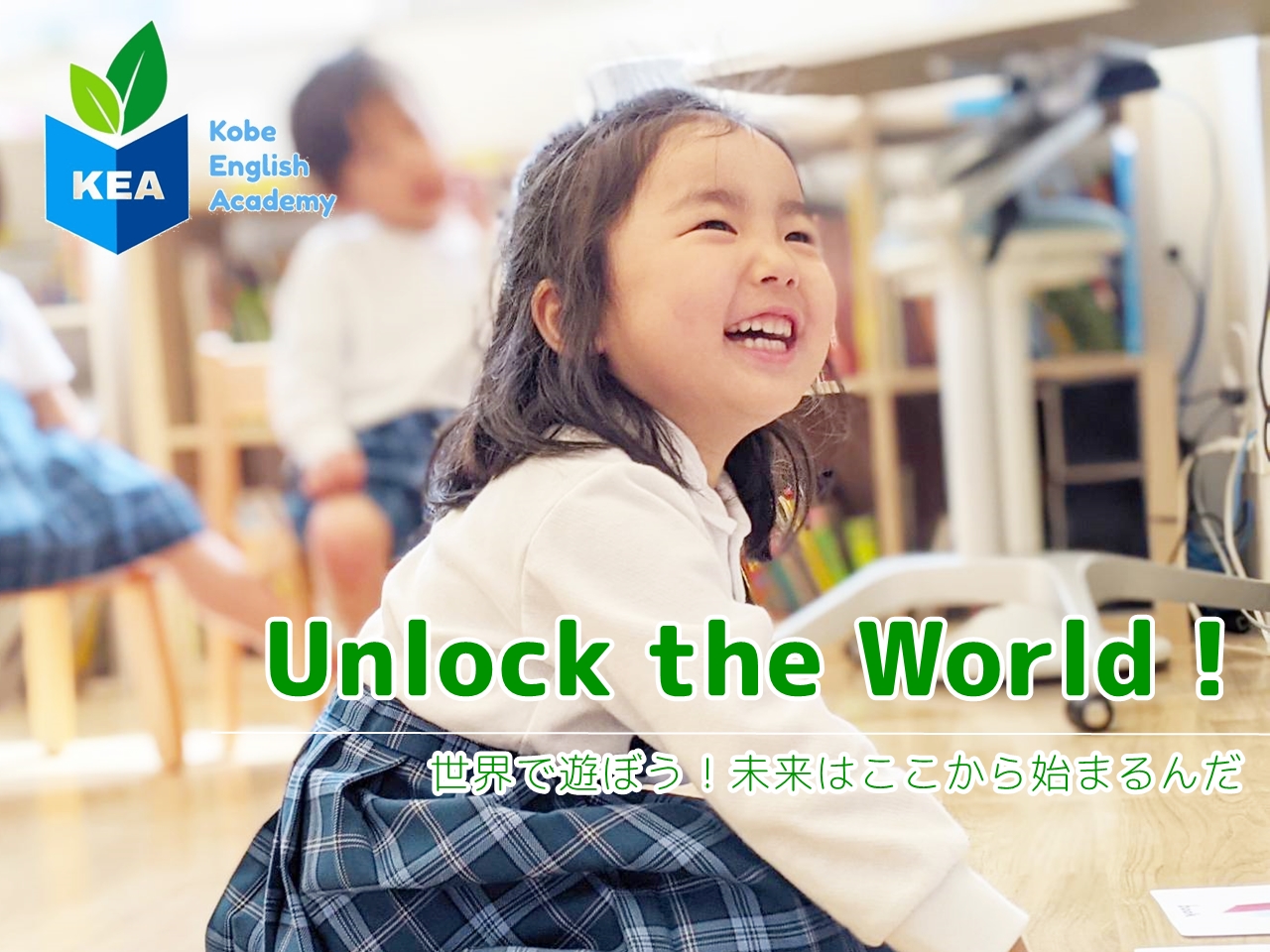
カリキュラムについて
What will children learn?
・主体性 ”あなたはどうしたいのか、どう考えるのかが日常的に問われます”
・多様性 ”他人の意見と自分の意見が異なることこそ面白いという文化を作ります”
・自信 ”子どもを一人の人間として尊重することで、子どもの自信が育っていきます”
・リーダーシップ ”仲間のために何かをやってあげる経験、そこから得られる喜びを重視します”
・表現力 ”言葉で伝えたいことを伝える、言葉を通して感情を交流させることを大切にしています”
・思考力 ”考える機会を与え、考える時間はゆっくり待ちます”
・判断力 ”選択/判断する経験を重ねます。ゲーム等のツールを利用することもあります”
・規律 ”人間としてルールを守ることは重要です。ルールの意味を自分で納得するところ からスタートします”
・学ぶ姿勢 ”学ぶことの楽しさを伝え続けます”

English 英語

At Kobe English Academy (KEA), we realize that each child is unique and that each child learns in a different way. Our teachers use a variety of methods and activities to ensure that each student can be successful.
K1 class (3-4 years)
Speaking: In the first year of kindergarten, the students increase their vocabulary greatly and use that new vocabulary to interact with each other and ask questions. The K1 students also learn a greater variety of useful sentences.
Reading/Phonics:K1 phonics lessons teach the individual sounds of each letter as well as an anchor word (or words) that begin with that sound. This helps the student remember the phonetic sounds of the letter more quickly. (ex: “A says / a/, /a/, /a/, apple). After learning the letter sounds well, the students start to combine the letter sounds and we study word families (ex: ~at word family: cat, hat, bat, sat,…).
Writing/Spelling: The K1 students learn how to write all upper-case and lower-case letters. We teach the proper stroke order and the students practice writing everyday. The K1 students also practice teacher led group spelling activities of simple three-letter words using phonics. (ex: Teacher says: “How do we spell cat?” Students with help from teacher break the word apart into its sounds. Teacher says, “What is the first sound in cat?” Students say, “/c/!” Teacher says, “What letter makes the /c/ sound?” Students say the letter and write it together.
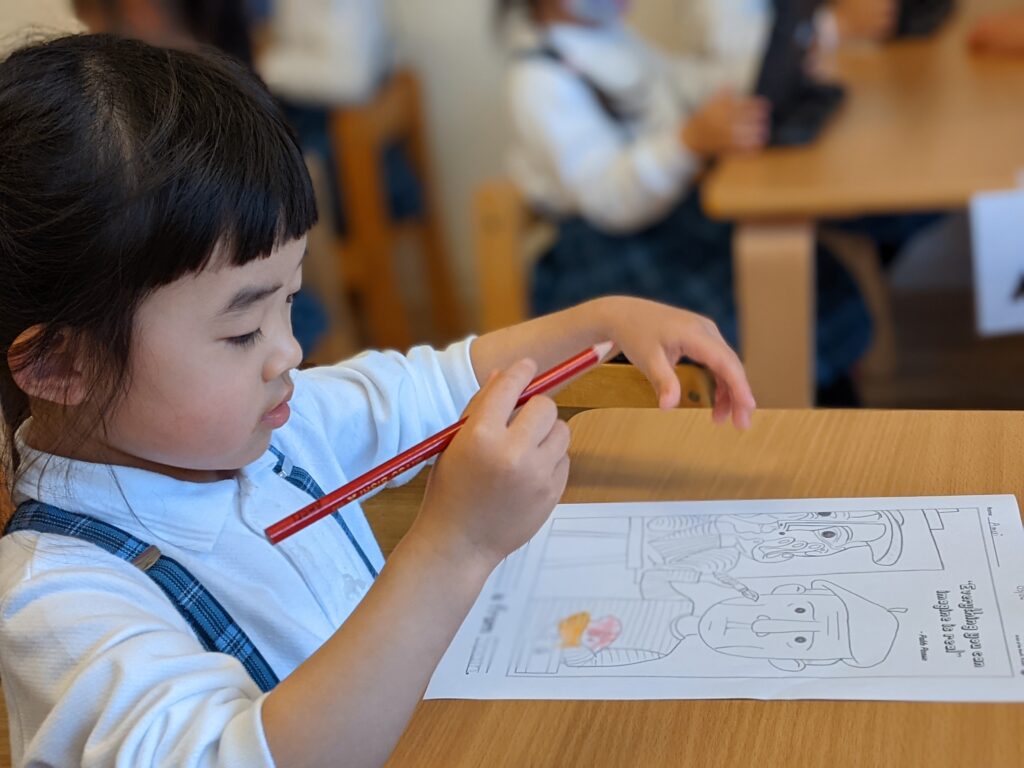
K2 class (4-5 years)
Speaking:Speaking: The K2 class begins learning more advanced vocabulary and uses longer sentences. They continue to interact with the new vocabulary in conversation and begin to use English to express their feelings and ideas.
Reading/Phonics: The K2 students are able to read longer words with basic vowel sounds. They also start to learn double-letter combinations (ex: /ch/, /sh/, /ee/, /ea/,…). The K2 class also begins learning about ‘magic-e’ words (ex: Cute, sale, mine,…)and practices reading using leveled readers in addition to simple picture books.
Writing/Spelling: The K2 students focus on improving the neatness of their handwriting and practice writing their letters in a smaller size. K2 Students also start writing full sentences during free-writing activities where they can express themselves by writing what they like and draw a picture to match their sentences. They also practice spelling words individually, as well as trying to spell new unfamiliar words using ‘inventive spelling’, a method where students make an educated guess at the spelling using their phonetic knowledge (ex: “flawrs” for “flowers” or “prpul” for “purple”). This is an important first stem in the process of not only becoming a good speller, but also a good reader and writer.
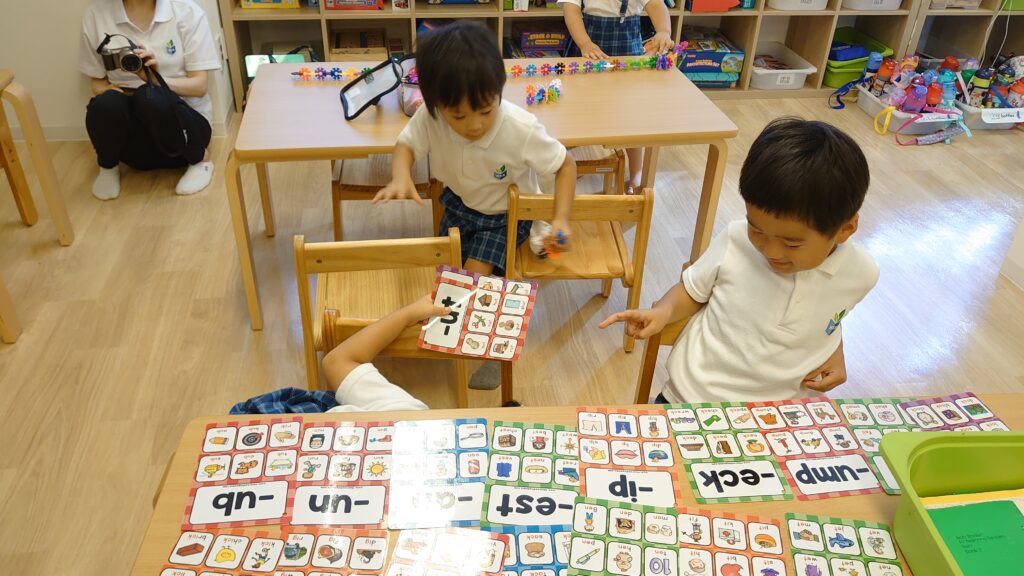
K3 class (5-6 years)
Speaking: The K3 class continues learning more advanced vocabulary and grammar. They also begin to express themselves a lot more and talk about their lives in greater detail. They also become more active in conversations. At the beginning of each lesson, the K3 students have time to talk about their lives and share things with their classmates and the teacher. During this time, the K3 students listen more closely, take in the information, and ask their own thoughtful questions. At this point, they are able to communicate at a high level using English in a natural way.
Reading/Phonics: The K3 class continues to read longer ‘magic-e’ words (ex: plane, shine, smoke) and learns to read more difficult phonetic patterns (ex: /kh/, /wr/, /eigh/,…). The students also learn about compound words, two separate words that can combine to make a new word (ex: butter + fly = butterfly). At the end of the K3 year, students are able to read longer picture books. The students can also read and gather information and be able to answer comprehension questions based on that text. They are also able to read scripts and perform plays and puppet shows.
Writing/Spelling: K3 students continue to practice spelling words by themselves based on patterns they study. They also continue using ‘inventive spelling’, but need to rely on it less as they learn more spelling patterns and become better spellers. In the K3 class, we also practice adding more detail to their free-writing sentences by learning to answer “Who?” “What?” “When?” “Where?” and “Why?” in their writing.
*up to 16 students per class.
KEAの英語教育の特徴は、丁寧なフォニックス(英語の音)の指導です。年少から年長までの3年間で、フォニックスのルールをコツコツ積み上げた生徒は、インターナショナルスクール小学部からの学習にもスムーズに移行することが出来、小学校入学以降も英検などで出題される英語長文読解への土台が身に付いています。
KEAは、英語検定試験の準会場に登録されています。KEA Daily class の生徒は、児童英検は年少~、英検は年長児~いつものスクールの教室で検定試験を受験することができます。例年多くの生徒がチャレンジし表彰されています。2023年では、児童英検で100点満点の生徒が4名ありました。一問も間違わない集中力も素晴らしいと感心しました。子ども達は、KEAを卒業し小学生になってもアフタースクール、サタデースクールなどに通学し、受験級を更新しています。

![]() KEAは、の「日本英語検定協会(英検)」と「児童英検」の「準会場」として認定されています。
KEAは、の「日本英語検定協会(英検)」と「児童英検」の「準会場」として認定されています。
英語検定
②対象生徒は、K3の生徒から小学校高学年程度
③対象級は、英検5級から準2級まで
⑤英検の対策レッスンも行っています
児童英検
②対象生徒は、K1から小学校低学年程度
③対象級は、BRONZE、 SILVER、 GOLD
⑤児童英検の対策レッスンも行っています
Inquiry-Based Leaning 探求学習

・Inquiry-based Learning (IBL)ってなに ?
Inquiry-based Learning (探求学習)とは、子ども達が主体的に課題を見つけその課題を探求的に学習する学習活動です。不確実なこれからの社会を生き抜くにあたって、とても重要視され多くの教育現場で取り入れられている学習活動の一つです。
学習者 には①課題を設定する力、課題解決に向けて、②情報を収集、③整理・分析する力 が備わります。周囲とコミュニケーションを取りながら、協働的に進めていくた め、④まとめ・表現する力も育まれます。
KEAでは、探求学習は日本語で行っています。IBLの探求活動を通じて、子ども達の日本語(聞く、話す、読む、書く)の能力も身につけながら、より深い対話を経験していくことがねらいです。

文部科学省『小学校学習指導要領解説・総合的な学習の時間編』
IBL 学習の活動例(K1 class 年少)

⒈子ども達は「ふしぎ」を見つける天才︕
子ども達にとっては、すべての出会いが「初めて」です。 子ども達の世界はドキドキとワクワクでいっぱいです。そんな子ども達のスクールの日常には 「これなに」 「どうして」 「やってみたい」などの言葉があふれています。年少児は、まずスクール生活に慣れることを優先的に考え、スクールが安心できる場所になるよう、エデュケーターは、丁寧に子ども達に寄り添い、つながりをしっかりと作ります。そしてエデュケーター とのつながりができたら、今度は子ども達同士のつながりを作れるよう促します。日々の「遊び」を通して社会性を身につける活動を展開し、その「遊び」の中から子ども達の行動、表情、言葉を丁寧にくみ取ります。

IBL 学習の活動例(K2 class 年中)
文字がまだ読めない子ども達には絵本を読んであげたり、動画を一緒に見たりして情報収集のサポートをします。文字が読めるよ うになったら、日本語だけでなく、英語の絵本や動画にも触れる機会を作り、子ども達は自ら情報を収集するようになります。
K1でしっかりとした土台づくりをしてきた分、「好心を形に」をキーワードに、主体的で、より高度な活動を始めてい きます。エデュケーターは子ども達に、様々な活動を紹介したり促したりします。ここでは大人が望むような活動を「させ る」のではなく、課題に沿った活動をいくつか紹介し、子ども達が自ら選択し(自己選択)、そのアイデアを具現化できる ようサポートします。

IBL 学習の活動例(K3 class 年長)
小学校進学に向けて「深い学び」をキーワードに、さらに高度な活動に取り組みます。子どもに理解できるのかと心配される活動もあるかもしれませんが、子どもの育つ力は大人が考えている以上です。子ども達にできるだけたくさんの「質の高い活動」を提供し、大いに学習を楽しんでもらいます。教育の質とは、子どもの「経験の質」であると私たちは考えてい ます。一つの経験がさらなる経験への好奇心となり、より深い学びが起きるよう、しっかりとサポートし、小学校への へと自身をもって進められるように過ごします。

探求しながら、自分とは違う意見、 考えを持った友達はどう感じているか、それをすることで「社会性」「多様性への理解」が身につきます。それはご家庭での「遊び」とは違い、集団の中に身を置くことで備わる力です。Show and Tell (発表)、Debate (話し合い) 、Reflection Note (まとめノートづくり)を利用し、エデュケーターとの対話によって、より深く広く考えられるよう促し、次の課題設定へとつなげて いきます。
K3では小学校進学に向けて、文字や算数活動も積極的に取り入れていきます。「文字」を使って本を読む楽しさ、自分の考えや思いを伝えられる嬉しさも子ども達に味わってほしいと考えています。

年長児は、卒業プロジェクトとして、お別れ遠足の行き先や、行く方法・料金を調べたり、チャリティーウィークの寄付先など、いくつかの活動を自分たちで話し合って決めてもらっています。
2024年度卒業生たちは、ドナルド・マクドナルド・ハウス神戸を調べて、他の学年にも説明を行い、必要な物の寄付を集めました。

Digital Literacy デジタルリテラシー
生まれたときからデジタルな世界に囲まれて生きている子ども達にとって、テクノロジーを理解し、使いこなす力は避けては通れない道と考えます。テクノロジーを安全に使うことや、何が出来るのかを知ることが、これからの時代の担い手となる子どもには必要です。AIやVRが進化し、想像して作れないものはないほど、デジタル世界の可能性は無限大です。 子ども達が大人になる頃には、あらゆる業界でデジタルの知識を使い、新しい物やサービスを作り出す社会になることは明らかです。KEAでは、一人1台のタブレットやデジタル機器を使い、英語でその広い世界を紹介していきます。
生まれたときからデジタルな世界に囲まれて生きている子ども達にとって、テクノロジーを理解し、使いこなす力は避けては通れない道と考えます。テクノロジーを安全に使うことや、何が出来るのかを知ることが、これからの時代の担い手となる子どもには必要です。AIやVRが進化し、想像して作れないものはないほど、デジタル世界の可能性は無限大です。 子ども達が大人になる頃には、あらゆる業界でデジタルの知識を使い、新しい物やサービスを作り出す社会になることは明らかです。KEAでは、一人1台のタブレットやデジタル機器を使い、英語でその広い世界を紹介していきます。
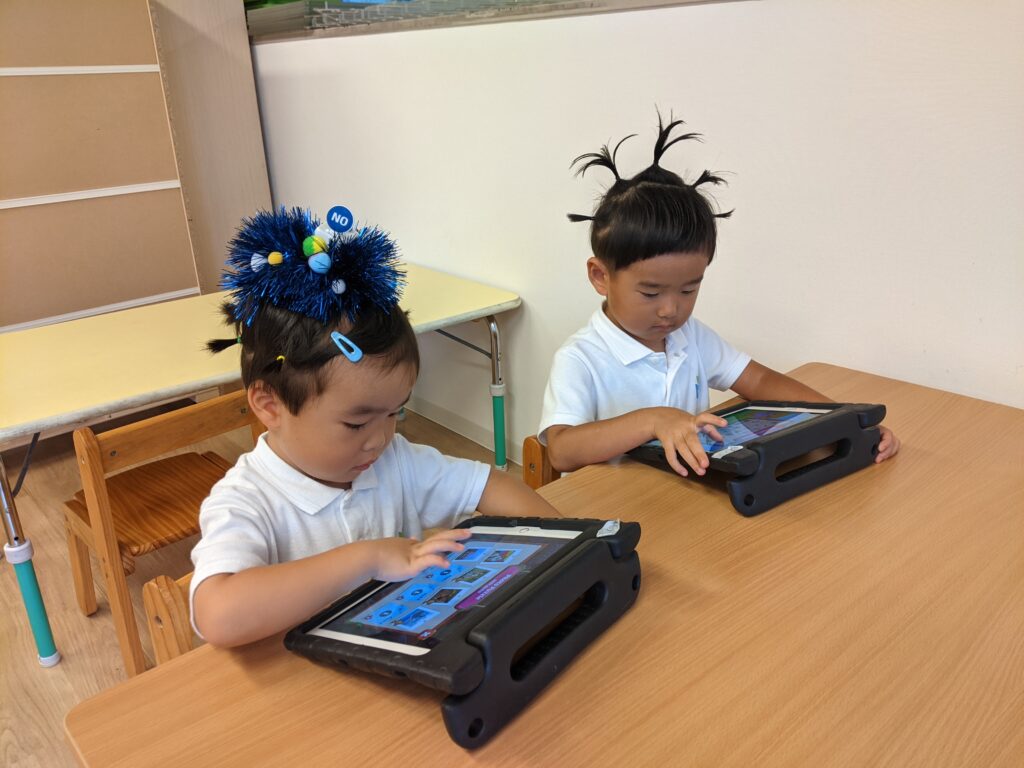 |
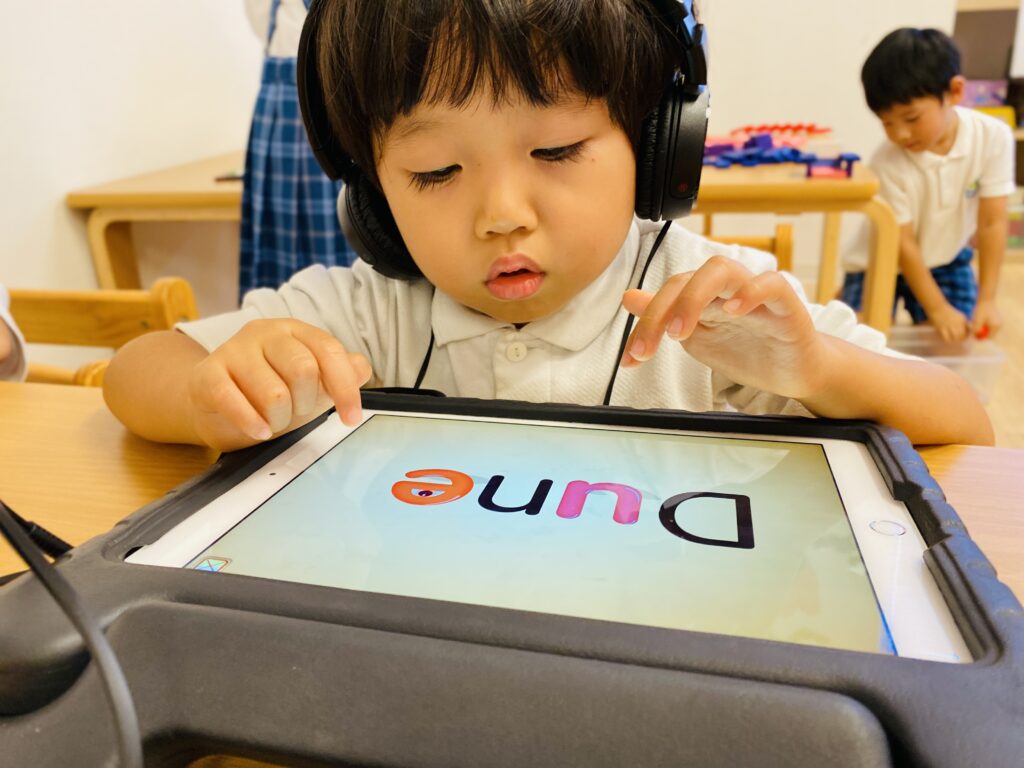 |
Multiple Choices 選べる卒業後の進路
KEAは、文科省の「幼児期の終わりまでに育ってほしい10の姿」に沿った指導を行っています。私達のこれまでのインターナショナルスクールでの指導経験から、是非取り入れたいと考えていたことが、日本の幼児期の教育にある手法だったからです。卒園後には、日本の私立・公立校、インターナショナルスクール、いずれも選べる選択肢となるでしょう。しっかりと日本の教育も補っていきます。日本の社会に求められる知識や習慣、日本語の豊かな語彙で表現する力、日本が誇るマナーや自律のマインド、日本らしい丁寧で細やかな気配りも、経験豊富な保育士、幼稚園教諭、小学校教諭などの有資格者がサポートしています。
Parental Support ご家庭との連携
・普段の生活を丁寧に
私たちは幼児期という、一番大切な時期を共に過ごしていることを理解しながら子ども達と関わっています。 人間形成、学習習慣の基盤を作る為のとても重要な土台は、基本的な生活習慣が確立しているということです。 基本的な生活習慣の確立とは、「自分の身の周りのことが自分でできる」ようになること「規則的な生活習慣が 身につく」ということ。それは、日々の積み重ねであり、丁寧な繰り返しです。この時期を外してしまうと、よ りよい生活習慣が定着せず、逆に好ましくない習慣が形成されると、後の修正が困難となってしまいます。良い 習慣を身につけるためには、スクールだけでは足りません。スクールとご家庭との連携を密にとり、必要な時は 生活習慣の見直しや指導、サポートをさせていただくことがあります。KEAは、お子さまの豊かな未来を創造す るためのパートナーとお考え下さい。
・子どもにとっての最高の居場所
子どもにはいつでもありのままの自分を受け止めて、認めてくれる環境が必要です。信頼できるスタッフが そばにいること、安全かつ安心して過ごせるスクールであることで、子どもは、自己を最大限に発揮でき、自 己肯定感が高まります。また保護者の皆さまにとっても、居心地のよい家庭の延長の場所でありたいと思って います。
・保護者との連携ʼParentingʼ
質の高い教育に向かうためには、スクールとご家庭との連続性が重要です。急速に変化する時代においては、 広い視野をもって子どもの未来を考える必要があります。KEAでは、Parentingという保護者向け講座を展開し、 保護者の皆さまにも学び手となっていただきます。ご一緒にお子さんの豊かな未来を考えていきましょう。


